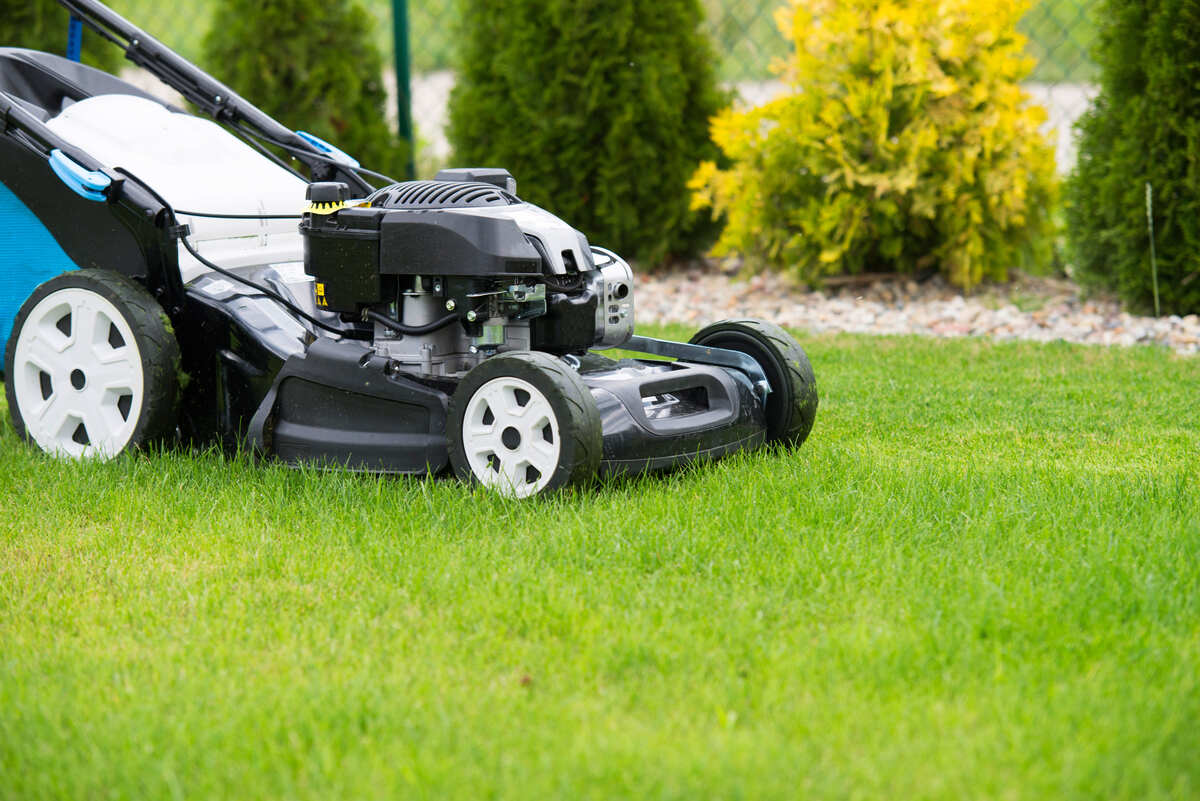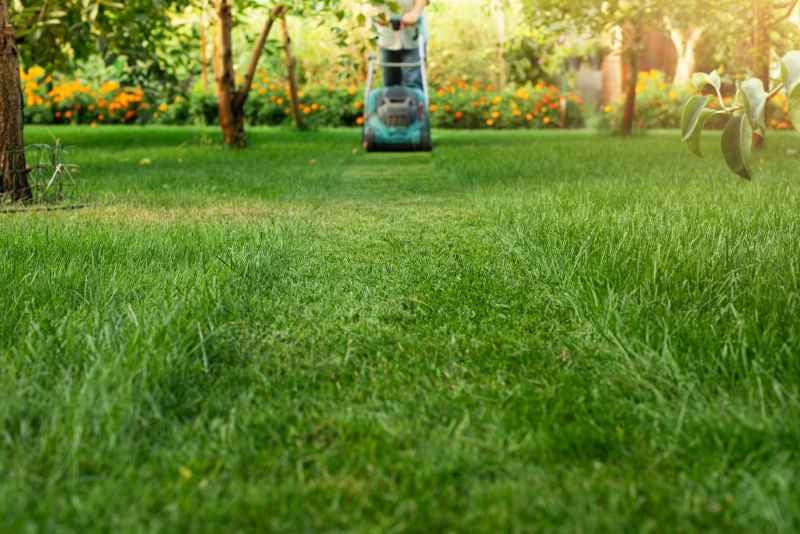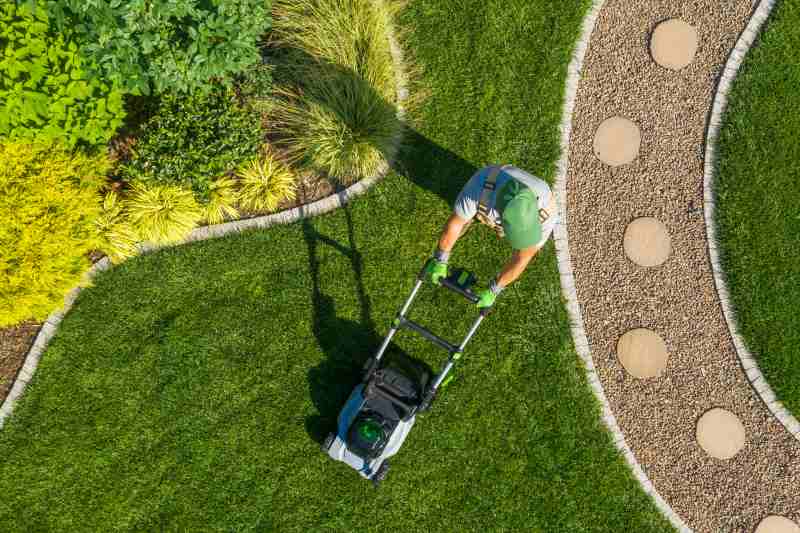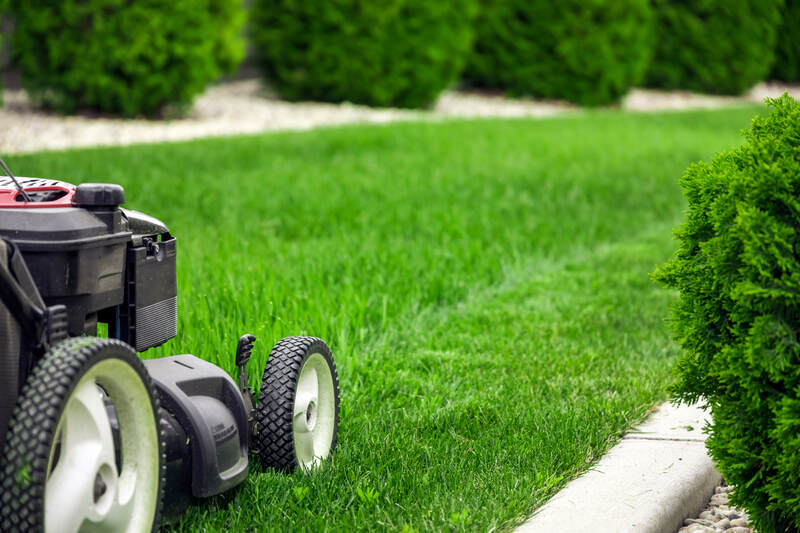
Most people are accustomed to following a set schedule each day. To stay healthy, your lawn also needs to follow a certain schedule, which includes mowing it at the right time.
Mid-morning, between 8 a.m. and 10 a.m., is the best time of day to mow grass. Avoiding conditions that are too hot, too moist, and too late (or early) in the day reduces stress on your lawn and gives it plenty of time to recover before nightfall. With tips from an expert, here are the best (and worst) times of day to mow grass.
| Time of Day | Hours | Rating |
| Early morning | 6 to 8 a.m. | ★☆☆☆☆ |
| Mid-morning | 8 to 10 a.m. | ★★★★★ |
| Late morning | 10 a.m. to noon | ★★★☆☆ |
| Midday | Noon to 3 p.m. | ★★☆☆☆ |
| Late afternoon | 4 to 6 p.m. | ★★★★☆ |
| Evening | After 6 p.m. | ★★☆☆☆ |
The Best Times to Mow Your Lawn

Mowing your grass at the best time of day is one of the easiest things you can do to promote a healthy lawn. Here is a guide to the best (and worst) times to mow your lawn:
Mid-Morning (8-10 a.m.)
★★★★★
The best time of day to cut grass is mid-morning, between 8 a.m. and 10 a.m.
Here’s why it’s the ideal time:
- Less moisture: The morning dew has typically dried by this time. Mowing wet grass is one of the worst things you can do for your lawn. The blades will tear, and the clippings will clog your mower, so mowing after the dew dries is the way to go.
- Cooler time of day: By mowing mid-morning, you protect your grass from heat stress.
- Recovery: Your lawn needs time to recover before the sun goes down. With the night comes moisture and an increased risk of disease and fungal infections.
“People make so many mistakes when mowing because they think as long as they get the grass short, they’ve succeeded,” says Daniel Tengrove, owner of All Southern Lawn & Landscaping in Ocala, Florida. “When you mow plays a big part in how healthy and strong your grass will be.”
| You have a lot to fit into your schedule, and it’s difficult to make time for mowing. Find a LawnStarter pro to take care of your lawn care for you. Our customers pay an average of $48 per mowing service. |
Late Afternoon (4-6 p.m.)
★★★★☆
If you’re not a morning person, don’t worry, Tengrove says. The second best time to mow your lawn is late afternoon or early evening, from 4 p.m. to 6 p.m. Here’s why:
- Low moisture: No dew on the grass means you won’t have to worry about poor cutting performance or encouraging disease on your lawn.
- Cooler time of day: Mowing after the hottest part of the day prevents heat stress.
- Recovery: Your lawn will have enough time to recover before nightfall, reducing the risk of disease.
Late Morning (10 a.m.-noon)
★★★☆☆
There are both benefits and drawbacks to mowing your grass in the late morning hours, from 10 a.m. to noon:
- Low moisture: The grass should be dry, so you won’t have to deal with the hassle of mowing wet grass.
- Too hot: After 10 a.m., the day might be too hot to mow the lawn without stressing it (or you), especially in hot climates. Heat stress can hinder your turfgrass’s ability to recover.
- Recovery: Mowing grass in the morning hours gives it enough time to recover before nightfall.
The Worst Times to Mow Your Lawn

Early Morning (6-8 a.m.)
★☆☆☆☆
The worst time to mow your lawn is early morning, between 6 a.m. and 8 a.m. Here are the reasons why:
- Too much moisture: In the early morning, dew still covers your turf. Cutting wet grass leaves your grass more susceptible to lawn diseases or fungus.
- Compacted soil and ruts: “Cutting wet grass is one of the worst things you can do,” Tengrove says. The mower blade will tear wet grass instead of slicing it cleanly, the soil will compact, and your lawn will have ruts.
“Even a small mower can leave ruts in wet soil,” he adds, “and once they are there, they’re staying.” - Clogged mower: Trimming the lawn when it’s wet can clog or damage your lawn mower.
- Too much noise: Mowing during early morning hours is not considered neighborly, since loud mowing disrupts the quiet. Some areas even have policies against it.
See Related:
Midday (noon-3 p.m.)
★★☆☆☆
Although the grass will be dry midday, there are more disadvantages than benefits to mowing at this time:
- Dry grass: The one advantage of mowing midday is that the grass will be dry.
- Unsafe heat: It’s not safe for homeowners to mow midday in areas that experience extreme heat, which can cause heat stroke or sunburns.
- Slow grass recovery: Midday heat can stress mowed grass. Although your grass should recover before nightfall, heat stress can still weaken your lawn.
Evening (After 6 p.m.)
★★☆☆☆
Another one of the worst times to mow your lawn is in the evening, after 6 p.m. Here’s why mowing late in the day is a problem for your lawn:
- Susceptible to lawn diseases: Grass cut in the evening may not heal and recover before nightfall. The moisture that forms overnight can cause lawns cut late in the day to be more susceptible to disease and fungus.
When is the Best Time to Mow During Each Season?

With a change in seasons comes a change in how you do lawn care. Here are the best times of day to mow in each season of the year.
| Season | Best Time to Mow | Notes |
| Spring | 8-10 a.m., after the dew evaporates, or 4-6 p.m. | Spring is usually the rainy season. Opt for a later mowing time, if needed, to allow the dew and rainwater to evaporate. |
| Summer | 8-10 a.m., after the dew evaporates, or 4-6 p.m. | Don’t mow dormant or drought-stricken grass during the summer. If you experience summer storms, wait until the grass is dry before you mow. |
| Fall | 8 a.m.-noon | During fall, the best mowing time depends on the local temperatures. |
| Winter | Mowing isn’t necessary if the lawn is dormant. | If your lawn continues to grow in winter (common only in extreme southern areas), mow during the warmest time of the day. |
See Related:
- When to Mow Your Yard This Spring
- Dormant Grass vs. Dead Grass
- Mowing Height Debate: Last Mow of the Season Low?
- When to Stop Mowing the Lawn Before Winter
FAQ About the Best Time to Mow Grass
Don’t mow when there is a drought. In times of intense heat and low water, grass will go dormant. Cutting dormant grass can damage it.
See Related: How to Take Care of Your Lawn During a Drought
Most daytime pollinators are active during the warmest parts of the day, so mowing from 8 a.m. to 10 a.m. means you’ll avoid bothering most pollinators in your lawn.
To prevent noise pollution in the early hours of the day, some areas have laws about when homeowners can mow. Most ordinances say you should wait until at least 7 a.m. to 8 a.m. before you start mowing your lawn. If you’re an early bird, check your local ordinances before mowing season begins.
Find a Pro to Mow Your Lawn
Mowing your lawn at the right time of day, between 8 a.m. and 10 a.m., promotes healthy grass, prevents lawn diseases, and protects both you and your grass from the dangers of extreme temperatures, especially in summer.
The prime mowing months are busy, and it’s hard to find time to mow your lawn. Leave this arduous lawn chore to a lawn care professional so that you and your family can enjoy other activities during the warmer months.
Read More: When Not to Mow Your Lawn
Sources:
- Daniel Tengrove, owner of All Southern Lawn & Landscaping, Ocala, FL. Personal interview.
- “Exploring Relationships Between Time of Day and Pollinator Activity in the Context of Pesticide Use.” By agriculture and food science experts Arrian Karbassioon and Dara A. Stanley. “Basic and Applied Ecology.” Volume 72, November 2023, pp. 74-81.
Main Image Credit: irontrybex / Adobe Stock / License